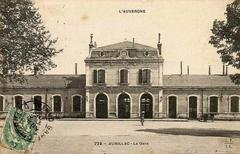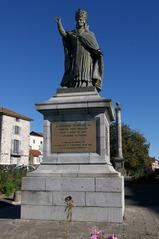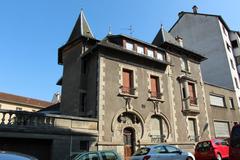Maison Consulaire d’Aurillac: Complete Visiting Guide, History, and Visitor Information
Date: 14/06/2025
Introduction: An Icon of Aurillac’s Civic and Cultural Heritage
Located in the heart of Aurillac, France, the Maison Consulaire d’Aurillac—also known as the Consular House or Hôtel des Consuls—stands as a prominent symbol of the city’s civic pride and architectural heritage. This historic building has played a central role in Aurillac’s municipal life from the late Middle Ages through the Renaissance and into modern times. With its striking volcanic stone façade, intricate carvings, and centuries-old function as a seat of governance, the Maison Consulaire is a must-see for visitors interested in French history, architecture, and local culture. Now protected as a Monument Historique, it welcomes the public for guided tours, exhibitions, and cultural events, offering an immersive journey through Aurillac’s past and present (Monumentum; Pays Aurillac Tourisme; Base Mérimée).
Table of Contents
- Introduction
- Historical Origins and Construction
- Architectural Features and Artistic Details
- Civic Functions and Noteworthy Events
- Preservation and Heritage Status
- Visitor Information: Hours, Tickets, and Accessibility
- Highlights and Travel Tips
- Frequently Asked Questions (FAQ)
- Conclusion and Next Steps
- References
Historical Origins and Construction
The Maison Consulaire’s origins date back to the late medieval period, with significant reconstruction and expansion during the Renaissance and the 18th century. The building was commissioned by the city’s consuls—elected officials overseeing municipal governance—who sought a dedicated, stately space that would reflect Aurillac’s growing importance as a regional center. Completed by the early 18th century, the site was strategically placed near the Place de l’Hôtel de Ville, reinforcing its status as the hub of civic life. The design, attributed to master masons inspired by classical French civic architecture, features local volcanic stones such as pinkish basalt and Volvic stone, lending it both strength and a distinctive appearance (Monumentum; Aurillac Patrimoine).
Architectural Features and Artistic Details
Exterior and Materials
The façade is a standout example of provincial French architecture, with:
- Ashlar masonry: Precise stone blocks, predominantly volcanic in origin, giving the building its characteristic dark hue (Pays Aurillac Tourisme).
- Mullioned windows: Tall, vertical stone-divided windows typical of late Gothic and early Renaissance styles.
- Wrought-iron balconies and a sculpted entrance portal adorned with Renaissance-inspired carvings, heraldic symbols, and the city’s coat of arms.
Decorative and Interior Elements
- Intricate carvings on the entrance and window surrounds, including motifs such as foliage, coats of arms, and geometric patterns, emphasize the building’s public function (Pays Aurillac Tourisme).
- Elegant timber framing in some sections, reflecting the hybrid construction techniques across various periods (Notre France).
- Vaulted ceilings, restored woodwork, and an original wrought-iron staircase inside.
Civic Functions and Noteworthy Events
Originally, the building housed the city’s consuls, who managed municipal affairs, justice, and commerce. Over the centuries, it also served as:
- Municipal council headquarters after the Revolution
- Local tribunal for minor civil and criminal cases
- Electoral hall until 1809
- Theater and cultural venue in the 19th and 20th centuries
It played a role in key historical moments, such as:
- Hosting political gatherings during the French Revolution (1789)
- Serving as a center for local resistance activities during World War II (Archives Départementales du Cantal)
Preservation and Heritage Status
The Maison Consulaire has been listed as a Monument Historique since 1926 (Base Mérimée). This designation ensures rigorous preservation of its architectural features and interior spaces. Restoration efforts have focused on maintaining the integrity of its Gothic and Renaissance elements while adapting the building for modern use as a museum and event space. All repairs and enhancements comply with strict heritage guidelines.
Visitor Information: Hours, Tickets, and Accessibility
Visiting Hours
- Tuesday to Sunday: 10:00 AM – 6:00 PM (last entry at 5:30 PM)
- Closed on Mondays and public holidays
- Hours may vary during festivals and special events; check the official website for updates.
Tickets
- General admission: €5
- Free: Residents of Aurillac and children under 12
- Reduced rate: €3 for students and seniors
- Guided tours: Included in admission; available in French daily at 11:00 AM and 3:00 PM, English on weekends. Book online or at the site.
Accessibility
- Ground floor: Wheelchair accessible with ramps and adapted restrooms
- Upper floors: Accessible by stairs; staff assistance available on request. Contact ahead for special accommodations.
Highlights and Travel Tips
- Museum of the Old Town: The Maison Consulaire often hosts exhibitions featuring historical engravings, paintings, and civic artifacts.
- Notable objects: Includes a registered statuette of the Virgin and Child (Wikipedia).
- Location: At the intersection of rue Marcenague and rue Coste, central to medieval Aurillac and near the Place de l’Hôtel de Ville.
- Nearby attractions: Church of Saint-Géraud, Aurillac Museum of Art and Archaeology, Muséum des Volcans, and medieval streets with timber-framed houses.
- Public transport: Short walk from the train station; nearby parking at Place de l’Hôtel de Ville.
- Combine your visit: Explore Aurillac during street theatre festivals or European Heritage Days for special events.
Frequently Asked Questions (FAQ)
Q: What are the Maison Consulaire’s opening hours?
A: Open Tuesday to Sunday, 10:00 AM to 6:00 PM. Closed Mondays and public holidays.
Q: What is the admission fee?
A: €5 general, €3 reduced. Free for Aurillac residents and children under 12.
Q: Are guided tours offered?
A: Yes, daily in French and weekends in English. Check schedules in advance.
Q: Is the monument accessible for people with disabilities?
A: The ground floor is accessible; upper levels may require assistance.
Q: Can I take photos inside?
A: Photography is allowed, except during some exhibitions.
Q: What else is nearby?
A: Château de Saint-Étienne, Muséum des Volcans, Abbaye Saint-Géraud, medieval streets, and lively local markets.
Conclusion and Next Steps
The Maison Consulaire d’Aurillac is not just a historic structure—it is the beating heart of Aurillac’s civic and cultural identity. Its layered history, elegant architecture, and ongoing role as a hub for community life make it essential for any visitor seeking to understand the city’s past and present. Whether you are an architecture enthusiast, history lover, or cultural traveler, a visit to the Maison Consulaire offers a window into the story of Aurillac and its people.
Plan your visit today: For the latest on visiting hours, ticketing, events, and guided tours, consult the official Aurillac tourism website or download the Audiala app for up-to-date information and personalized recommendations. Follow Aurillac’s social media channels for announcements, festival updates, and exclusive heritage content.
References
- Monumentum
- Pays Aurillac Tourisme
- Base Mérimée
- Aurillac.fr
- Notre France
- Wikipedia
- Archives Départementales du Cantal



